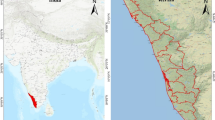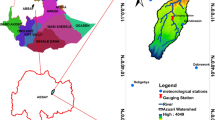Abstract
The Multan district is mainly prone to riverine floods but has remained understudied. Chenab flood-2014 was the worst flood that this district experienced in recorded history. This study applies remote sensing (RS) techniques to estimate the extent, calculate duration, assess the major causes and resulting impacts of the flood-2014, using Landsat-8 OLI images. These images were obtained for pre-flood, during-flood and post-flood instances. Secondary data of flood causing factors were obtained for comprehensive analysis. Spatially trained and validated datasets were obtained through Google Earth platform and Global positioning system. The supervised classification with maximum likelihood algorithm was used to classify land use and land cover of the study area. The Modified Normalized Difference Water Index was utilized to detect flood inundation extent and duration, and Normalized Difference Vegetation Index was utilized to monitor vegetation coverage and changes. The analysis allowed us to assess flood causes, and calculate the extent of the flooded areas with duration and recession, as well as damages to standing crops and built-up areas. The results revealed that the flood-2014 occurred due to heavy rains in early September in upper Chenab catchment. The flood inundation continued for around two months, which heavily affected agriculture and built-up areas. The present study introduces practical use of RS techniques to provide basis for effective flood inundation mapping and impact assessment, as an application for early flood response and recovery in the world.









Similar content being viewed by others
Data availability
The datasets used and/or analyzed during the current study are available from the corresponding author on reasonable request.
References
Al Faisal A, Al Kafy A, Roy S (2018) Integration of remote sensing and GIS techniques for flood monitoring and damage assessment: a case study of Naogaon District, Bangladesh. J Remote Sens GIS 7:2
Alphan H, Doygun H, Unlukaplan Y (2008) Post-classification comparison of land cover using multitemporal Landsat and ASTER imagery: the case of Kahramanmaras, Turkey. Environ Monit Assess 151:327–336
Atif I, Mahboob AM, Waheed A (2016) Spatio-temporal mapping and multi-sector damage assessment of 2014 flood in Pakistan using remote sensing and GIS. Indian J Sci Technol 9(1):1–11
Bhatt CM, Rao GS, Farooq M, Manjusree P, Shukla A, Sharma SVSP, Kulkarni SS, Begum A, Bhanumurthy V, Diwakar PG, Dadhwal VK (2016) Satellite-based assessment of the catastrophic Jhelum floods of September 2014, Jammu & Kashmir, India. Geomat Nat Haz Risk 8(2):309–327
Cann KF, Thomas D, Salmon RL, Wyn-Jones AP, Kay D (2012) Extreme water-related weather events and waterborne disease. Epidemiol Infect 141:1–16
Chignell S, Anderson R, Evangelista P, Merritt LM (2015) Multi-temporal independent component analysis and Landsat 8 for delineating maximum extent of the 2013 Colorado front range flood. Remote Sens 7:9822–9843
Chohan K, Ahmad S, Islam Z, Adrees M (2015) Riverine flood damage assessment of cultivated lands along Chenab river using GIS and remotely sensed data: a case study of District Hafizabad, Punjab, Pakistan. J Geogr Inf Syst 07:506–526
Cook A, Merwade V (2009) Effect of topographic data, geometric configuration and modeling approach on flood inundation mapping. J Hydrol 377:131–142
Domeneghetti A, Schumann GJP, Tarpanelli A (2019) Preface: remote sensing for flood mapping and monitoring of flood dynamics. Remote Sens 11(8):943
Federal Flood Commission Islamabad (FFCI). (2014) Annual flood report. Ministry of Water and Power, Pakistan
Forget Y, Linard C, Gilbert M (2018) Supervised classification of built-up areas in sub-saharan african cities using landsat imagery and OpenStreetMap. Remote Sens 10(7):1145
Gaurav K, Sinha R, Panda PK (2011) The Indus flood of 2010 in Pakistan: a perspective analysis using remote sensing data. Nat Hazards 59(3):1815–1826
Giordan D, Notti D, Villa A, Zucca F, Calò F, Pepe A, Dutto F, Pari P, Baldo M, Allasia P (2018) Low cost, multiscale and multi-sensor application for flooded area mapping. Nat Hazard 18:1493–1516
Giustarini L, Chini M, Hostache R, Pappenberger F, Matgen P (2015) Flood hazard mapping combining hydrodynamic modeling and multi annual remote sensing data. Remote Sens 7:14200–14226
Government of Pakistan (GoP) (2017) District census report of Multan, Population Census Organization, Islamabad
Halgamuge M, Nirmalathas A (2017) Analysis of large flood events: based on flood data during 1985–2016 in Australia and India. Int J Disast Risk Reduc 24:1–11
Hashmi H, Siddiqui Q, Ghumman AR, Ahmed Kamal M, Mughal HUR (2012) A critical analysis of 2010 floods in Pakistan. Afr J Agric Res 7:1054–1067
Islam AS, Bala S, Haque MA (2010) Flood Inundation map of Bangladesh using MODIS time-series images. J Flood Risk Manag 3:210–222
Khalid B, Cholaw B, Alvim DS, Javeed S, Khan JA, Javed MA, Khan AH (2018) Riverine flood assessment in Jhang district in connection with ENSO and summer monsoon rainfall over Upper Indus Basin for 2010. Nat Hazards 92(2):971–993
Khan B, Iqbal MJ (2013) Forecasting flood risk in the indus river system using hydrological parameters and its damage assessment. Arab J Geosci 6:4069–4078
Khan SI, Hong Y, Gourley JJ, Khattak MU, De Groeve T (2014) Multi-sensor imaging and space-ground cross-validation for 2010 flood along Indus river, Pakistan. Remote Sens 6:2393–2407
Lu D, Mausel P, Brondi Zio E, Moran E (2007) Change detection techniques. Int J Remote Sens 25(12):2365–2407
Mahmood S, Rani R (2018) Extent of flood damages in Chenab Basin, Upper Indus Plain. Nat Hazards Risk Assess Vulnerabil Reduct. https://doi.org/10.5772/intechopen.79687
Mahmood S, Khan AH, Mayo SM (2016a) Exploring underlying causes and assessing damages of 2010 flash flood in the upper zone of Panjkora River. Nat Hazards 83(2):1213–1227
Mahmood S, Khan AH, Ullah S (2016b) Assessment of 2010 flash flood causes and associated damages in Dir Valley, Khyber Pakhtunkhwa Pakistan. Int J Disaster Risk Reduct 16:215–223
Mahmood S, Rahman A, Sajjad A (2019a) Assessment of 2010 flood disaster causes and damages in district Muzaffargarh, Central Indus Basin. Pakistan Environ Earth Sci 78(3):63
Mahmood S, Rahman A, Shaw R (2019b) Spatial appraisal of flood risk assessment and evaluation using integrated hydro-probabilistic approach in Panjkora River Basin. Pakistan Environ Monit Assess 191:573
Mahmood S, Sajjad A, Rahman A-u (2021) Cause and damage analysis of 2010 food disaster in district, Muzaffar Garh, Pakistan. Nat Hazards 107:1681–1692
Munasinghe D, Cohen S, Huang YF, TsangYP ZJ, Fang Z (2018) Intercomparison of satellite remote sensing based flood inundation mapping techniques. J Am Water Resour Assoc 54:834–846
Musa ZN, Popescu I, Mynett A (2015) A review of applications of satellite SAR, optical, altimetry and DEM data for surface water modelling, mapping and parameter estimation. Hydrol Earth Syst Sci 19:3755–3769
National Disaster Management Authority (NDMA) (2014) Annual flood report, Islamabad
Notti D, Giordan D, Caló F, Pepe A, Zucca F, Galve J (2018) Potential and limitations of open satellite data for flood mapping. Remote Sens 10(11):1673
Pakistan Meteorological Department (PMD) (2014) Annual report, Regional Meteorological Observatory, Lahore
Pradhan B, Shafiee M, Pirasteh S (2010) Maximum flood prone area mapping using RADARSAT images and GIS: Kelantan River basin. Int J Geoinform 5:11
Punjab Provimcial Disaster Management Authority (PPDMA) (2014) Annual flood report, Lahore
Rahman A, Khan AN (2011) Analysis of flood causes and associated socio-economic damages in the Hindu Kush region. Nat Hazards 59(3):1239
Rahman A, Khan AN (2012) Analysis of 2010-flood causes, nature and magnitude in the Khyber Pakhtunkhwa. Pakistan Nat Hazards 66(2):887–904
Rahman G, Rahman A, Anwar M, Khan M, Ashraf H, Zafar U (2017) Socio-economic damages caused by the 2014 flood in Punjab Province, Pakistan. Proc Pakistan Acad Sci 54:365–374
Revilla-Romero B, Hirpa F, Thielen-del Pozo J, Salamon P, Brakenridge R, Pappenberger F, De Groeve T (2015) On the use of global flood forecasts and satellite-derived inundation maps for flood monitoring in data-sparse regions. Remote Sens 7:15702–15728
Rokni K, Ahmad A, Selamat A, Hazini S (2014) Water feature extraction and change detection using multitemporal Landsat imagery. Remote Sens 6:4173–4189
Sajjad A, Lu J, Chen X, Chisenga C, Mahmood S (2019) The riverine flood catastrophe in august 2010 in south Punjab, Pakistan: potential causes, extent and damage assessment. Appl Ecol Environ Res 17(6):14121–14142
Sajjad A, Lu J, Chen X, Chisenga C, Saleem N, Hassan H (2020a) Operational monitoring and damage assessment of riverine flood-2014 in the lower Chenab Plain, Punjab, Pakistan, using remote sensing and GIS techniques. Remote Sens 12(4):714
Sajjad A, Lu J, Chen X, Chisenga C, Saleem N (2020b) Rapid riverine flood mapping with different water indices using flood instances Landsat-8 images. https://doi.org/10.3390/ECWS-5-08049
Sanyal J, Lu XX (2004) Application of remote sensing in flood management with special reference to monsoon asia: a review. Nat Hazards 33:283–301
Schumann G, Bates P, Apel H, Aronica G (2018) Global flood hazard mapping, modeling, and forecasting, pp 239–244
Smits PC, Dellepiane SG, Schowengerdt RA (1999) Quality assessment of image classification algorithms for land-cover mapping: a review and a proposal for a cost-based approach. Int J Remote Sens 20:1461–1486
Syvitski J, Brakenridge R (2013) Causation and avoidance of catastrophic flooding along the Indus River, Pakistan. GSA Today 23:4–10
Tariq M, van de Giesen N (2012) Floods and flood management in Pakistan. Phys Chem Earth 47–48:11–20
Uddink MMA, Meyer FJ (2019) Operational flood mapping using multi-temporal Sentinel-1 SAR images: a case study from Bangladesh. Remote Sens 11:1581
Wulder M, Masek J, Cohen W, Loveland T, Woodcock C (2012) Opening the archive: how free data has enabled the science and monitoring promise of Landsat. Remote Sens Environ 122:2–10
Xu H (2006) Modification of Normalized Difference Water Index (NDWI) to enhance open water features in remotely sensed imagery. Int J Remote Sens 27:3025–3033
Acknowledgment and Funding
This work was funded by the National Key Research and Development Program (2018YFC1506506), the Frontier Project of Applied Foundation of Wuhan (2019020701011502), Key Research and Development Program of Jiangxi Province (20201BBG71002), and the LIESMARS Special Research Funding.
Author information
Authors and Affiliations
Contributions
SA and JL conceptualized overall research design; image analysis, flood inundation maps, LULC maps and flood impact assessment were contributed by SA; validation was contributed by SA, JL and CC; investigation was contributed by CX; writing—original draft preparation was contributed by SA; writing—review and editing were contributed by SA, JL, NM and BN.
Corresponding author
Ethics declarations
Conflict of interest
The authors declare that they have no conflict of interest.
Ethics approval and consent to participate
Not applicable.
Consent for publication
Not applicable.
Additional information
Publisher's Note
Springer Nature remains neutral with regard to jurisdictional claims in published maps and institutional affiliations.
Rights and permissions
About this article
Cite this article
Sajjad, A., Lu, J., Chen, X. et al. Riverine flood mapping and impact assessment using remote sensing technique: a case study of Chenab flood-2014 in Multan district, Punjab, Pakistan. Nat Hazards 110, 2207–2226 (2022). https://doi.org/10.1007/s11069-021-05033-9
Received:
Accepted:
Published:
Issue Date:
DOI: https://doi.org/10.1007/s11069-021-05033-9




